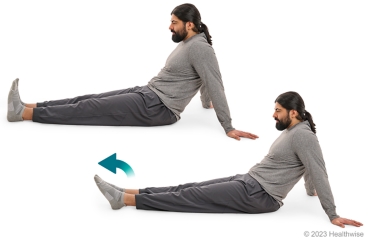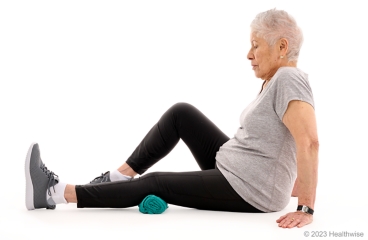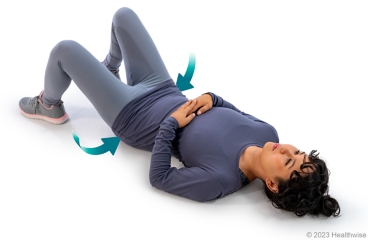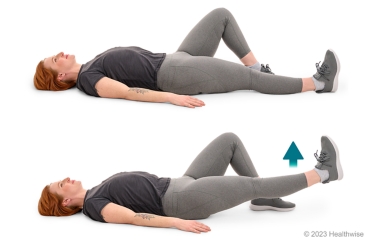Your Care Instructions
Here are some examples of rehabilitation exercises for hip surgery. Start each exercise slowly. Ease off the exercise if you start to have pain.
Your doctor or physical therapist will tell you when you can start these exercises and which ones will work best for you. He or she may tell you to do them in a certain way. You may need to do them several times each day.
When your doctor or therapist has you start the exercises, you can do them right on your bed.
If you've had a hip replacement, remember these important hip precautions:
- Don't lean forward while you sit down or stand up. Be careful to not bend at the hip past 90 degrees (like the angle in a letter "L").
- Keep your knees apart while you sit or lie down.
- Don't let your affected leg cross the center of your body toward the other leg.
- Keep your toes pointing up toward the ceiling. This will prevent rotation at the hip.
Cut back on your exercises if your muscles start to ache, but do not stop doing them.
How to do the exercises
Ankle pump

- Lie or sit on a firm surface with your feet out in front of you.
- Point your toes and feet up toward your knees as far as you can, then point them away from you as far as you can.
- Switch between pointing your feet up and pointing them down.
- Do this for 2 to 3 minutes, 2 or 3 times an hour.
Quad set

- Sit or lie down on a firm surface or the floor with your affected leg straight. Place a small, rolled-up towel under your knee.
- Tighten the thigh muscles of your straight leg by pressing the back of your knee down into the towel.
- Hold for about 6 seconds, then rest.
- Repeat 8 to 12 times.
- It's a good idea to repeat these steps with your other leg.
Glute set (knees bent)

- Lie on your back on a firm bed. Bend your knees, with your feet flat on the bed.
- Squeeze your buttocks together as tightly as you can. Hold for about 6 seconds.
- Repeat 8 to 12 times.
Hip flexion (lying down, leg straight)

- Lie on your back with your affected leg straight. You can bend your other leg, if that feels more comfortable.
- Tighten the thigh muscles in your affected leg by pressing the back of your knee down. Hold your knee straight.
- Keeping the thigh muscles tight and your leg straight, lift your affected leg up so that your heel is about 12 inches off the floor. Hold for about 6 seconds, then lower slowly.
- Repeat 8 to 12 times.
- It's a good idea to repeat these steps with your other leg.
Short-arc quad

- Lie on your back with your knees bent over a foam roll or a large rolled-up towel.
- Lift the lower part of your affected leg and straighten your knee by tightening your thigh muscle. Keep the back of your knee on the foam roll or rolled-up towel.
- Hold your knee straight for about 6 seconds. Then slowly bend your knee and lower your leg back to the floor.
- Repeat 8 to 12 times.
- It's a good idea to repeat these steps with your other leg.
Heel slide

- Lie on your back with your affected leg straight. Bend your other leg.
- Slowly bend your affected leg by raising your knee up while sliding your foot toward you. Bend your knee as much as you can.
- Hold for about 6 seconds. Then slowly slide your foot away, lowering your leg back down.
- Repeat 8 to 12 times.
- It's a good idea to repeat these steps with your other leg.
Hip abduction (lying on back)

- Lie on your back with your legs straight and your feet hip-width apart. Keep your toes pointed up toward the ceiling.
- Tighten the thigh muscles of your affected leg.
- Slowly slide the leg out to the side, then back. Be careful that your leg does not cross the center line of your body toward the other leg.
- Repeat 8 to 12 times.
- It's a good idea to repeat these steps with your other leg.
Current as of: July 24, 2025
Author: Ignite Healthwise, LLC Staff
Clinical Review Board
All Ignite Healthwise, LLC education is reviewed by a team that includes physicians, nurses, advanced practitioners, registered dieticians, and other healthcare professionals.

